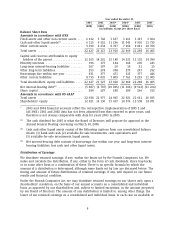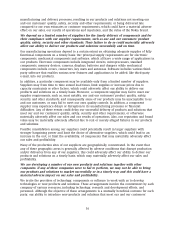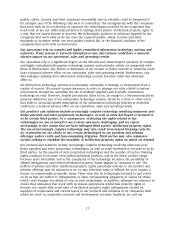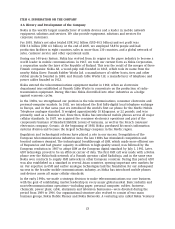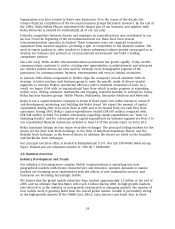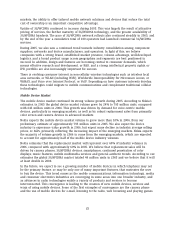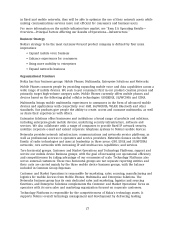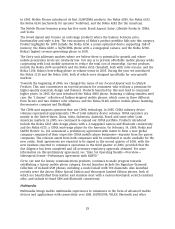Nokia 2005 Annual Report Download - page 21
Download and view the complete annual report
Please find page 21 of the 2005 Nokia annual report below. You can navigate through the pages in the report by either clicking on the pages listed below, or by using the keyword search tool below to find specific information within the annual report.a patent challenge is not successful, it could be expensive and time-consuming, divert
management attention from our business and harm our reputation. Any diminution of the
protection that our own intellectual property rights enjoy could cause us to lose some of the
benefits of our investments in R&D, which may have a negative effect on our results of operations.
See ‘‘Item 4.B Business Overview—Patents and Licenses’’ for a more detailed discussion of our
intellectual property activities.
The global networks business relies on a limited number of customers and large multi-year
contracts. Unfavorable developments under such a contract or in relation to a major
customer may adversely and materially affect our sales, our results of operations and cash
flow.
Large multi-year contracts, which are typical in the networks industry, include a risk that the
timing of sales and results of operations associated with these contracts will differ from what was
expected when we first entered into such contracts. Moreover, such contracts usually require the
dedication of substantial amounts of working capital and other resources, which impacts our cash
flow negatively. Any non-performance by us under these contracts may have significant adverse
consequences for us because network operators have demanded and may continue to demand
stringent contract undertakings, such as penalties for contract violations.
Furthermore, the number of our customers may diminish due to operator consolidation. This will
increase our reliance on fewer larger customers, which may negatively impact our bargaining
position, sales and profitability.
Our sales derived from, and assets located in, emerging market countries may be materially
adversely affected by economic, regulatory and political developments in those countries or
by other countries imposing regulations against imports to such countries. As sales from
these countries represent a significant portion of our total sales, economic or political
turmoil in these countries could adversely affect our sales and results of operations. Our
investments in emerging market countries may also be subject to other risks and
uncertainties.
We generate sales from and have invested in various emerging market countries. As sales from
these countries represent a significant portion of our total sales and as these countries represent a
significant portion of the expected industry growth, economic or political turmoil in these
countries could materially adversely affect our sales and results of operations. Our investments in
emerging market countries may also be subject to risks and uncertainties, including unfavorable
taxation treatment, exchange controls, challenges in protecting our intellectual property rights,
nationalization, inflation, currency fluctuations, or the absence of, or unexpected changes in,
regulation as well as other unforeseeable operational risks.
Our sales, costs and results are affected by exchange rate fluctuations, particularly between
the euro, which is our reporting currency, and the US dollar, the Chinese yuan, the UK pound
sterling and the Japanese yen, as well as certain other currencies.
We operate globally and are therefore exposed to foreign exchange risks in the form of both
transaction risks and translation risks. Our policy is to monitor and hedge exchange rate exposure,
and we manage our operations to mitigate, but not to eliminate, the impacts of exchange rate
fluctuations. Our sales and results may be materially affected by exchange rate fluctuations.
Similarly, exchange rate fluctuations may also materially affect the US dollar value of any
dividends or other distributions that are paid in euro. For more information, see ‘‘Item 5.A
Operating Results—Overview—Certain Other Factors—United States Dollar,’’ ‘‘Item 5.A Operating
Results—Results of Operations—Exchange Rates’’ and ‘‘Item 11. Quantitative and Qualitative
Disclosures About Market Risk.’’
19


